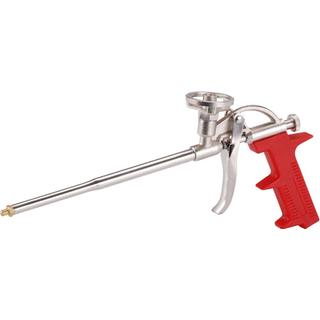It is used for fastening insulation materials onto construction surfaces.
The polyurethane adhesive used for sealing insulation plates is a low-expanding, one-component polyurethane foam, suitable for fastening insulation materials with the help of a sealant gun with pistol-grip handle assembly (gun grade PU foam). The polyurethane adhesive hardens due to air humidity.
It is suitable for easily, quickly, clean and effective gluing of Styrofoam, Styrodur, and mineral wool onto various construction surfaces (concrete, brick, wood). It is in accordance with European guidelines ETAG 004. It enables fast progress of works and provides additional thermal insulation.
Surfaces should be stable, flat and clean. Before applying the polyurethane adhesive, the surface should be moistened with water. The moistening is important because it improves the adhesion and accelerates the hardening of polyurethane adhesive. The optimal temperature of the can at work is 20 - 25 °C. Apply the polyurethane adhesive onto the edges of the board and then on its surface in the form of W letter.
Precise dosage contributes to lower consumption of the polyurethane adhesive. With one can is possible to fasten 12 - 16 m2 of insulation material.
After applying the polyurethane adhesive onto the insulation plate, you should wait one minute before fixing it onto the wall. Once the insulation plate is fixed onto the wall, the polyurethane adhesive stops to expand. Levelling of plates can be done in 10 to 15 minutes after fixation. Surfaces with bigger unevenness should be levelled with a coarse lime cement based mortar before affixing insulation plates. In the case of some point convexity on the wall insulation plates should be grinded on the back side so that the exterior surface remains level. In the case that some rifts between insulation plates exist, these could be filled with the polyurethane adhesive. Already after two hours, the adhesive will get the appropriate mechanical characteristics and we can continue with mechanical fixation and further processing of the insulation plates. Additional insulation plates anchoring depend on the foundation quality. They should be always anchored on the buildings base, old plasters, old concrete surfaces as well as on the unloadbearing surfaces. If the first line of the insulation is not supported by the concrete plate or the lower facade edge is higher, U profile mechanical fixed on the loadbearing wall can be used as support.b When fixing the insulation plates in bad weather conditions like wind and rain, the scaffold should be properly protected. In windy bweather the protection of the buildings edges is especially important! bCured polyurethane adhesive should be protected against UV light.







